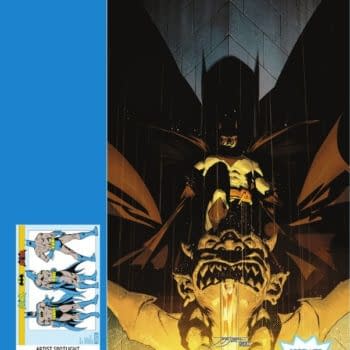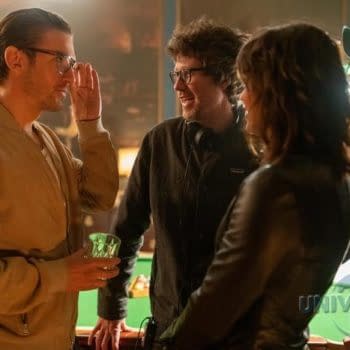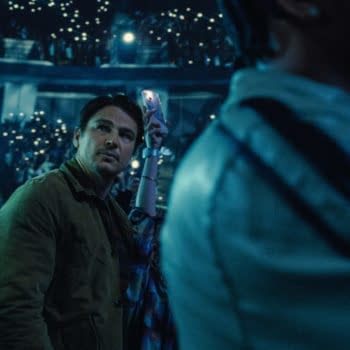Posted in: Movies | Tagged: arkham city, Batman, game, new york comic con, NYCC
NYCC: The Arkham City Panel
Eric Glover writes for Bleeding Cool
Salivating fans of the Batman: Arkham Asylum game got a tasty new tease of its highly anticipated sequel Batman: Arkham City on Friday, as well as some behind-the-scenes reveals by Rocksteady Studios creators and voice actor Kevin Conroy. The event kicked off with Arkham City's launch trailer, and followed up with a discussion about and demonstration of the game.
[youtube]http://www.youtube.com/watch?v=W60sVRoRpWw[/youtube]
Gameplay
Arkham City's game director Sefton Hill gave the crowd a generous preview of the sequel, which began at a point of the story in which Batman sets off to find the Joker. In order to reach him, Batman is forced to travel a considerable distance across Arkham City, the zoned-off section of Gotham handed to its criminals. As expected from the open-world format of the game, the feel of Batman's movement from one point to another is exhilaratingly freer.
Instead of the calculated creeping and crouching that distinguished the gait of Arkham Asylum, players are given an awe-inspiring experience of aerial fluidity; Batman can grapple a high point and release the cable at the last second, catapulting himself across a roof and gliding a bit before pulling himself forward once again with his grappling gun. With mastery of this method, Batman can "fly" continuously across the district with a combination of momentum and finesse. Additionally, Batman's ability to glide has been tweaked from a downward-only function to an asset that allows for motion similar to straight-out flight, enabling him to both lift as well as drop his position as he floats forward. Perhaps more importantly, Batman can use his more airborne role in the game to make steep dives toward enemies on the ground.
In an interesting progression from the first game's "audio awareness" of villains' intentions gained from relying on Arkham Asylum's PA system, Batman uses a radio earpiece keep him abreast of what Gotham's criminals are up to throughout the Arkham City (and in the case of the demo, Batman has honed in on Harley Quinn's frequency as she rambles about the Joker). Audio Director Nick Arundel mentioned that he wanted Batman's audio surveillance to tell the story without necessarily slowing Batman or narrative progress down. Batman is also in radio contact with Alfred, who seems to be just as capable as the previous game's Oracle in providing Batman with key information—and their respectful and easygoing rapport is a treat to hear.
Beyond Batman's heavier use of his earpiece, Hill showed off a couple of exciting new innovations related to Batman's gadgets. Arkham City's Batman now carries a remote electrical charge able to execute several tasks, one of which includes the ability to create electromagnetic fields. This field can draw metal objects toward it, and in the demonstration, the tool allows Batman to cause an otherwise inanimate object to begin swinging with enough momentum to destroy an obstruction in his path. The charge can also shock enemies and, like other gadgets in the game, can now be used quickly with a controller shorthand, rather than with the longer process of selection and employment required from Arkham Asylum.
These small innovations applied to Batman's utility belt go a long way in making the gameplay remarkably smoother than in the last installment, and a similarly successful improvement has been brought to Batman's animations, as well (which have apparently doubled this time around). One such example that got a roar from the crowd was Batman's ability to run, slide his body along the ground, and seamlessly rise to run again—a simple but satisfyingly slick addition to the character's aesthetic. Batman's ability to fight, as well, showed enough of a step up to enthrall onlookers. For instance, Batman is now able to take down two thugs at once, or catch objects thrown at him for a near-immediate toss back. Particularly enjoyable to watch is Batman's combo of a barrage of punches, which deals considerable damage to enemies much larger than himself.
Development
The Arkham City panel of guests generated its own excitement, mostly due to the presence of longtime Batman voice actor Kevin Conroy, but also because of the enthusiasm of Game Director Sefton Hill, Audio Director Nick Arundel, and Claudio Sanchez, the lead singer of Coheed and Cambria who recorded a song for Arkham City's original soundtrack. Between the four panelists seemed to be an air of modesty and an understanding of what kind of quality they owed the fans.
For instance, Hill matter-of-factly repeated that developing Arkham City wasn't about "going bigger," but giving the same amount of care and attention to the sequel's story as had given to the first game, albeit on a larger canvas—that larger canvas involving a world five times larger than the original, a scope big enough to include warring factions led by Arkham villains, and 30 hours of gameplay. Arundel chimed in with similar thoughts about making plot the top priority, saying that the new game is still "all about the narrative" (and apparently, seeds from that narrative were planted in the first game). Conroy added that Paul Dini, the writer behind Batman: The Animated Series, wrote a story for Arkham City that was still tied to the acclaimed narrative he'd created on TV, only adapted for a new format. Conroy went on to say that Dini understands the vulnerability of Batman, and how to get fans to respond to it. Correspondingly, Hill stated that villains were selected based on who would best challenge Batman, as well as say something about the character.
Arundel stated that it was even important for Batman's theme to inform players about who Batman is. Further regarding the music for Arkham City, Sanchez said that his band's contribution to its soundtrack, "Deranged," also explored character—although it's the Joker's perspective that his song investigated. Sanchez emphasized more than once how excited he was to be part of the project, creating and finishing the song within a day of being asked by game developers. Having grown up with Batman, his emotional connection to him fuelled his sense of commitment and excitement for the role he played in Arkham City's finished product.
Overall, the panel seemed emotionally honest with fans and expressed measured pride in the work that went into the game, which was well earned; the sequel looks to be an evolved, polished, and masterful addition to the Arkham Asylum franchise.

















